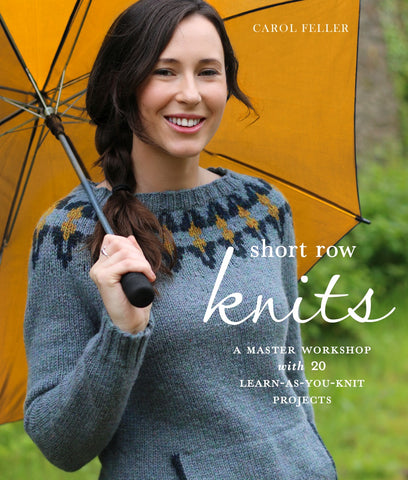We're delighted to have our yarn featured in Carol Feller's latest book, Short Row Knits. This book features a great technique section detailing four types of short row methods as well as twenty knitting patterns including a variety of sweaters and accessories.

As part of the blog tour, today we'll be taking a closer look at Zapote, a children's jacket, as well as the German short row technique.

The Zapote jacket is knit from the top down using German short rows to shape the hood. The shoulders are shaped in one piece with raglan increases, and the body is finished with an A-line shape and garter stitch pockets. It's super adorable! The pattern is sized from 6 months to 10 years and uses Yowza (shown here in Coventry).

German short rows are simple to work - but better yet, they're virtually invisible.
If you work a short row in knitting without some kind of wrap or extra stitch, you'll get an unsightly hole that disrupts the visual flow of the piece. German short rows solve this problem by creating a doubled stitch at the turning point by essentially pulling up a stitch from the row below.
Here's a little demo.
To work a German short row from the knit side, (1) knit to the turning point; turn; (2) slip the stitch purlwise from left to right and then (3) pull the working yarn up and over the right needle. Then bring the yarn down in between the needles (4) and purl across.

Yes, this feels like making a beginner mistake and it looks a little funky! But it creates a double stitch that will become virtually invisible in the finished fabric. When you go to work past those doubled stitches, be sure to knit both loops together as if they were one stitch. This is how that double stitch will look when you come to it:

Here's my swatch, front and back, after I've worked two short rows from the knit side and then knit two rows all the way across. You can hardly see - especially on the knit side - where the turns were, but the work is definitely at an angle now.

To work a German short row from the purl side, the technique is similar. Again, it's a little funky looking as you do it: (1) purl to the turning point; turn; (2) slip the stitch purlwise (with yarn in FRONT) from left to right and then (3) pull the working yarn up and over the right needle. Continue to knit from here. Again, when you come to the double stitch on the next row, (4) work it as if it were one stitch.

OK we can't resist another cute baby photo.

Helen adds... Knitting for babies is always satisfying - you finish a project rather quickly, and babies make everything look cute! Carol's adorable hooded jacket is sure to be a hit with the parents you know, and the clever hood shaping gives plenty of practice in the German short row technique. The simplicity of the sweater means it will be lovely in both monochromes and Babettes - just pick one that is appropriate for the intended recipient! My co-worker Alex has twin daughters who will turn one this coming spring... and I'm seriously thinking of picking two skeins that go well together and knitting a pair of jackets!
Finally, now for the fun giveaway part!
Comment here about your favorite color or colors for babies by midnight PST on October 1st (be sure to leave your email address so we can contact you) to be entered in the giveaway! We are giving away one copy of Short Row Knits and will choose a winner randomly. Thanks for reading and we hope you've learned something new about German short rows today!
The next stop on the Short Row Knits blog tour is with Stephannie Tallent on October 2.
Edited to add: Congratulations to Sylvia D, who was randomly selected as the winner! I've emailed to let her know to expect a copy of Short Row Knits in the mail.

81 comments
I prefer more rich and vibrant colors over pastels, such as Oz, Coos Bay, Aubergine, Plum, Cloak, Sweet Pea, and Franklin – to name just a few.
I love bright colors for babies! Especially greens and yellows because they’re perceived as “gender neutral”
I love neutrals for babies! Natural and undyed shades. But especially white, since putting babies in clothes you can’t bleach can make for a lot of sadness!
I like deep jewel tones for babies as opposed to the usual pastels. A dark eggplant would be my favorite for boy or girl.
My favorite colors for babies are usually deep jewel tones rather than the usual pastels. Dark eggplant would be my favorite for boy or girl.